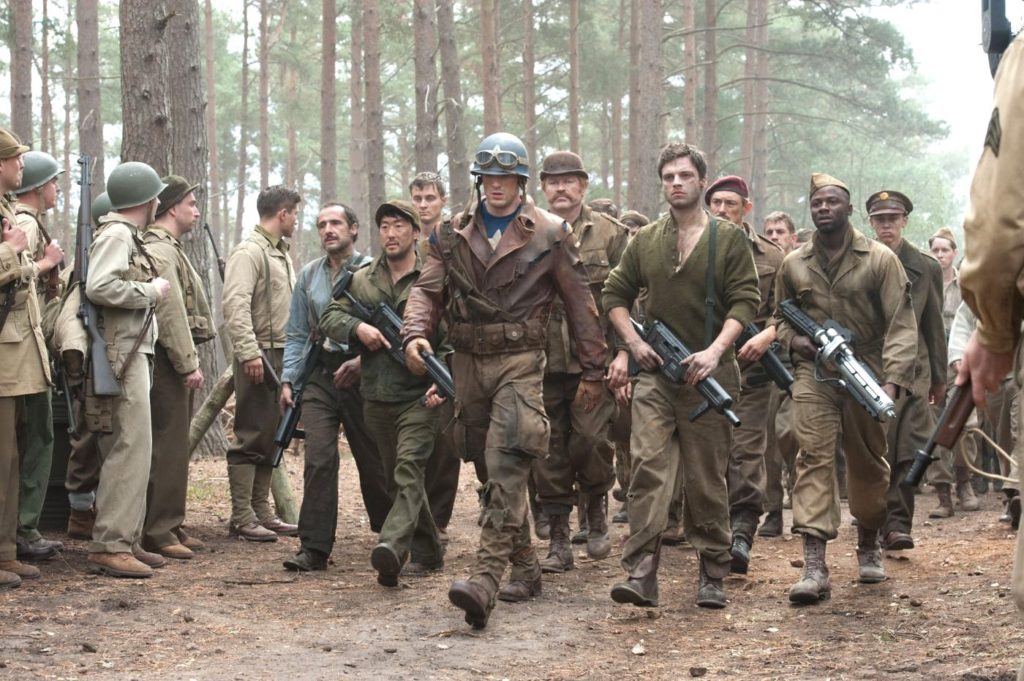
Nazis. We hate those guys.
When it comes to cinematic villains, they’re at the top of the list. (Or is it the bottom?) Oskar Schindler duped ’em. Rick Blaine shot one of ’em. Indiana Jones killed nearly a whole battalion of ’em.
Steve Rogers doesn’t care for Nazis much either. Hey, it’s the heart of World War II and the Axis powers are carving up Europe. How could he? But neither is he eager to go all Indiana on their sorry, movie-screen souls.
“I don’t want to kill anyone,” he confesses. But, he adds, “I don’t like bullies. I don’t care where they’re from.”
Steve knows all about bullies. The dude looks like he’s the 90-pound weakling in those Charles Atlas bodybuilding ads. He’s got the curvature of a pool cue, the strength of a partially melted Jell-O salad. He makes Michael Cera look like one tough hombre.
But that doesn’t negate the guy’s courage. Steve stands up to bullies wherever he sees them, and he obsessively tries to sign up for the war—even falsifying his records to get in. “There are men laying down their lives,” he says. “I have no right to do anything less.” But no military doctor will pass him.
Until, of course, he runs into mysterious and brilliant scientist Dr. Abraham Erskine, who drafts the lad into a secret government program designed to create super-soldiers through the wonders of cutting-edge chemistry. Steve seems the perfect candidate—not because of who he is on the outside, but who he is on the inside. Before long, the little guy finds himself strapped inside a coffin-like apparatus and infused with a weird assortment of drugs. And when the painful procedure is done, out steps …
Charles Atlas, of course.
No, no. It’s just Steve … only he’s about a foot taller and his shoulders are two feet wider. He looks ready to kick sand into the face of Adolph Hitler himself.
But those Nazis won’t leave well enough alone. Wanting the secret superhuman serum all to themselves, a spy sneaks into the lab and, before Steve can flex his mighty biceps just once, shoots several people and absconds with the formula. He doesn’t get far—Steve makes sure of that—but the formula’s destroyed and Erskine is dead. When the scientists made Captain America, they really did break the mold.
For those who mourn the dearth of real heroes in Hollywood, Marvel has your back. Captain America, aka Cap, is as pure and honest and obvious a hero as you’ll find in theaters these days—so good he could only be a work of fiction.
But within this fiction you can find some resonant themes. We learn that everything that really made Steve heroic was already inside him before they pumped him full of experimental serum. He stands up to bullies. He throws himself on (what he thinks is) a live grenade to save his fellow soldiers. He’s polite and generous and self-effacing and … well, just the sort of guy you’d like to represent your country in times of trouble.
It’s that sort of character that earned him the honor of being Erskine’s guinea pig. See, the first batch was actually used years earlier by a notoriously evil guy named Johann Schmidt, head of the super-secret Hydra wing of the Nazi military complex. The serum seemed to make this already bad Nazi a whole lot worse, so Erskine wants to restrict it to “good” men. Steve fits the bill. “The weak man knows the value of strength,” Erskine tells him. “And knows compassion.” And before the procedure begins, Erskine makes Steve promise one thing: “That you will stay who you are. Not a perfect soldier, but a good man.” Steve does just that, striving to be a “good man” through the entire course of this movie—capping his efforts with an act of heroic sacrifice.
The idea of drawing strength from weakness offers us a faint echo of Christianity. God seems to love to work through weakness, and we see that true heroism, while sometimes manifested through the body, finds its true source in the spirit and soul.
Those oblique suggestions of faith are marred a bit by some occult references, though. Schmidt is in possession of an energy cube of awesome power—one supposedly the stuff of Teutonic myth. We hear several times that the cube is a power that comes from “the gods.” “And the Fuhrer digs for trinkets in the desert,” Schmidt says dismissively—a nod to Raiders of the Lost Ark, in which the Nazis dig for the Ark of the Covenant, and perhaps to Indiana Jones and the Last Crusade, too, where the Holy Grail is the object in question.
Those who saw Thor earlier this year know that the cube comes from Thor’s home planet of Asgard, and that he and his kin actually aren’t gods, they were just perceived to be such by ancient humans. But that doesn’t wholly mitigate the references we hear here.
It’s hinted that Schmidt, also known as Red Skull, has been damned by taking a less-perfected form of the serum (which altered his appearance and perhaps made him even meaner). “You will burn!” a poor villager shouts. “I already have,” he says.
Some of the garb we see women wear here would be considered pretty provocative … in the 1940s. USO girls wear skimpy sequined outfits and dance in short skirts. Other women sport blouses that accentuate their breasts. Steve is given a heavy kiss by a female soldier (supposedly a “thank you” for the lives he saved). But he only has eyes for one woman—agent Peggy Carter. He admits to her that he’s never danced with a girl before. “I figured I’d wait,” he says. And when she asks what he’s waiting for, he says, “The right partner.” She later favors him with a kiss of her own.
After Steve undergoes his transformation, he walks out of the contraption shirtless—obviously impressing Peggy. When a civilian invites a female agent to have some fondue with him, Steve mistakes it as a suggestive, sexual invitation.
Violence is part and parcel of the superhero movie genre, so much so that some film critics have completely stopped talking about it. That makes this especially noteworthy: Captain America is more violent than many of its peers. Perhaps because the film serves as a war movie too.
Audiences see loads of fisticuffs, firefights and explosions—far too many to detail here. And unlike some superheroes, Cap doesn’t hesitate to kill his enemies.
Schmidt guns down a civilian, spattering bright-red blood. We also see a small exit wound in the man’s back. Another unfortunate ends his screen time in the blades of a propeller. (There’s a brief blood spray visible.) Folks fall from great heights, and one man is sucked into a weird energy vortex. Another is crushed by part of a building, and we see a bit of blood on his head.
Those are modern-tinged gory scenes in the middle of a movie that otherwise has the vibe of a 1940s serial: The body count is high, but the squirm factor low as scores of characters are simply zapped out of existence—with a bloodless blue poof—via futuristic weapons powered by the cube.
Steve apparently suffers some serious pain while being injected with the serum. A spy bites into a cyanide pill and dies, foaming at the mouth.
Jesus’ name is abused once; God’s a handful of times. “H‑‑‑” pops up about a dozen times, complemented by a few other choice words: “a‑‑,” “b‑‑ch,” “d‑‑n.” A Brit interjects “bloody.” We don’t see it, but it’s implied that one of the soldiers makes an obscene gesture, aiming it at Cap.
Captain America obviously owes his physique to an exotic cocktail of chemicals injected directly into his body. While this sort of behavior these days would probably get him dragged to Capitol Hill for hearings (and it certainly would disqualify him from the Tour de France), back in the 1940s, improving one’s life through the power of science and medicine seemed pretty A-OK. And because the film encourages us to embrace a more innocent ethos from days gone by, we’re asked to turn a blind eye to these steroids on steroids.
Erskine drinks some Schnapps the night before Steve’s big transformation, admitting later that he drank more than he should have. Steve, after his best friend dies, is found drinking in the bar; he laments the fact that his altered body (because of its regenerative powers) makes it physically impossible for him to get drunk. When he drafts a small team of soldiers over drinks at a bar, one soldier agrees, but says, “You gotta do one thing for me … open a tab.” Later, a man marvels at their ability to drink. “Where do they put that stuff?” he says.
In trying to get into the army, Steve falsifies his records. He later leaves base against orders (but does so in order to rescue 400 men from certain death, and when he comes back he gives himself up for disciplinary action). Schmidt shows disregard for the prisoners he’s forcing to build weapons. “Use up what strength they have, doctor,” he says. “There are always more workers.”
By definition, superhero movies are about … heroes. We’ve seen a bevy of them walk, run, jump and fly through our movie theaters during the last several years, and there’s no sign of them stopping.
But we haven’t seen a hero like Captain America in a long, long time.
Cap traces his comic book roots to World War II, when he was created to take on Nazis and fight for the American Way. He was always an unapologetically nationalistic figure, and in this new movie he still is. As such, the film is an intentional throwback to a more innocent, more optimistic time, before scandal and cynicism and cable news shout-fests had beaten our national character beyond recognition. This movie recalls the days when Americans—most of them, anyway—truly considered the country a beacon, a city on a hill. And Captain America represents what we’ve long thought to be what’s best about us: Strength. An uncompromising spirit. Bravery, sometimes brash, but polite and self-effacing too.
“You don’t give up, do you?” Schmidt groans at Cap during a climactic melee.
“Nope,” he says.
How very “American” his response is. Simple. Straightforward. This is a guy who lets his actions speak for him.
Now, we need not say Cap represents an America that, for the most part, only ever lived in its national imagination. We must point out that the film has a few troublesome problems, including its love of wall-to-wall violence and the fact that our main hero is partly the product of (when you really sit and think about it) some potentially problematic chemistry. It’s a little weird to cheer for a guy who got strong through scientific alchemy when most of us are warning our kids about the dangers of body- and mind-altering drugs.
And yet there’s an inescapable optimism here, a goodness. Captain America tells us that muscles and nifty shields are great and all, but true heroism comes from within. And that it never goes out of style.


Paul Asay has been part of the Plugged In staff since 2007, watching and reviewing roughly 15 quintillion movies and television shows. He’s written for a number of other publications, too, including Time, The Washington Post and Christianity Today. The author of several books, Paul loves to find spirituality in unexpected places, including popular entertainment, and he loves all things superhero. His vices include James Bond films, Mountain Dew and terrible B-grade movies. He’s married, has two children and a neurotic dog, runs marathons on occasion and hopes to someday own his own tuxedo. Feel free to follow him on Twitter @AsayPaul.
Our weekly newsletter will keep you in the loop on the biggest things happening in entertainment and technology. Sign up today, and we’ll send you a chapter from the new Plugged In book, Becoming a Screen-Savvy Family, that focuses on how to implement a “screentime reset” in your family!